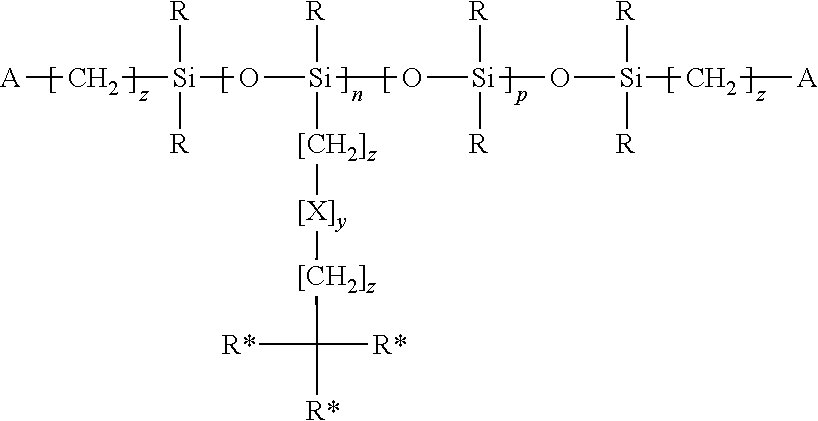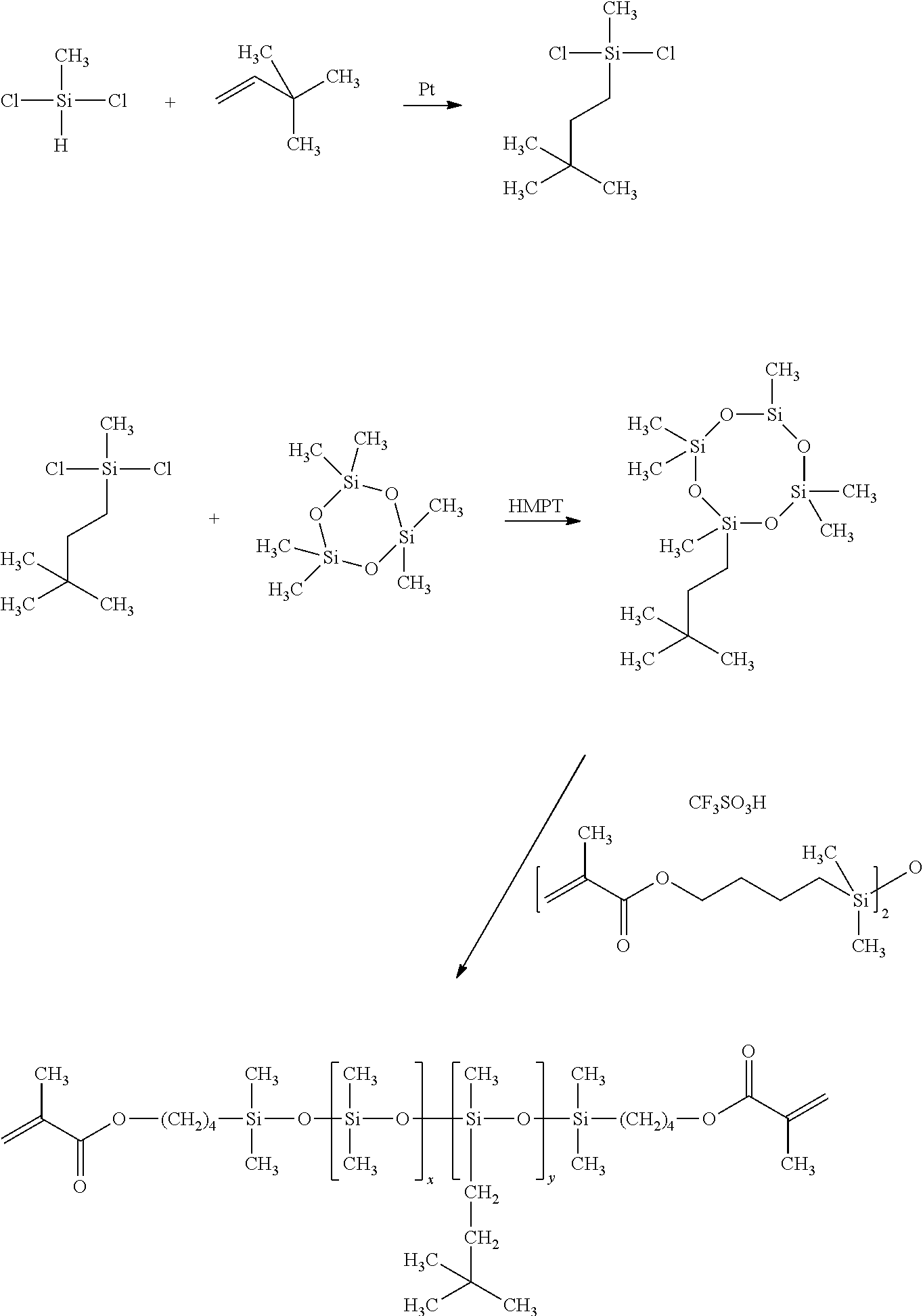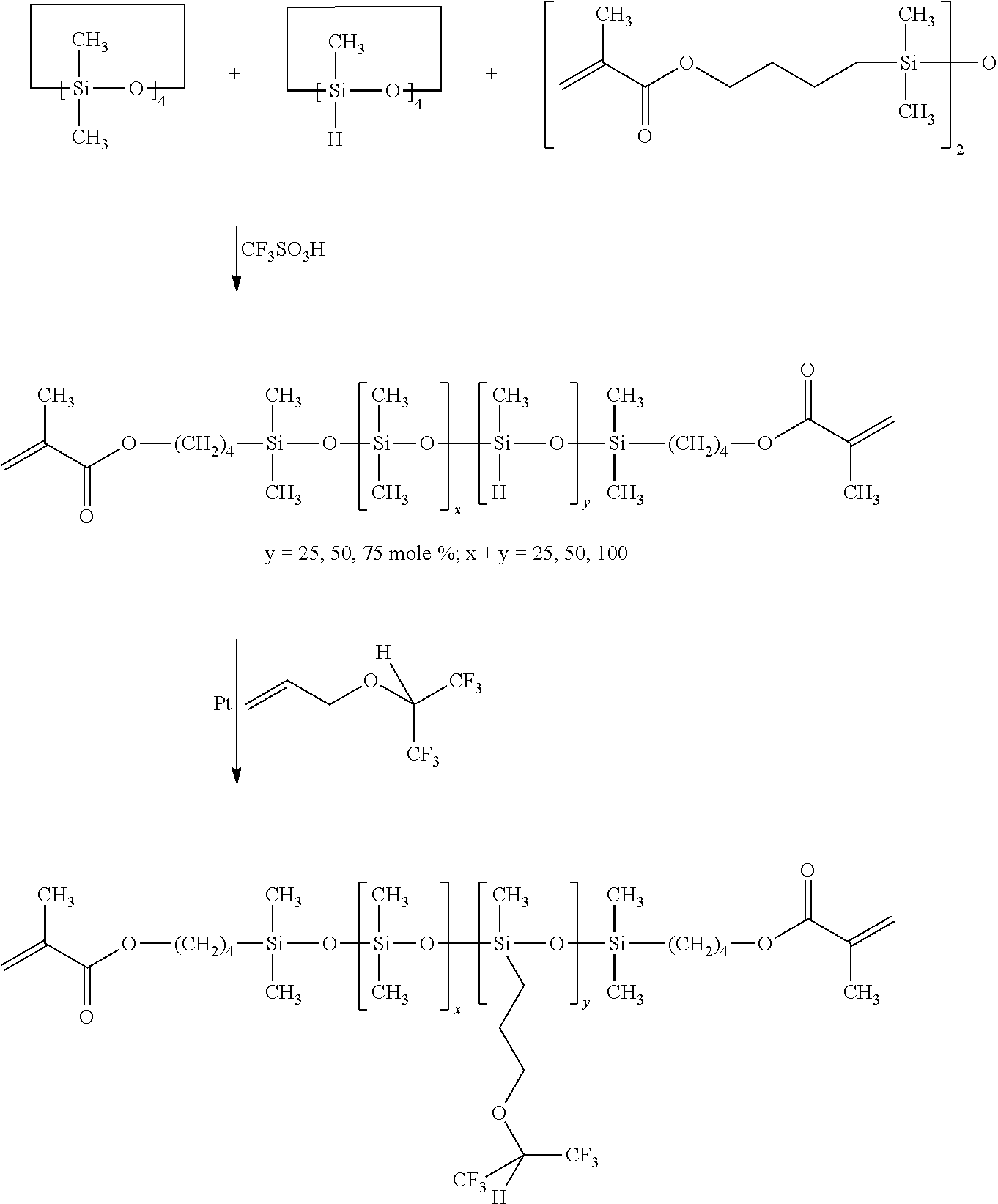Methacrylate-based bulky side-chain siloxane cross linkers for optical medical devices
a technology of optical medical devices and methacrylate, which is applied in the field of copolymers, can solve the problems of compromising other desired properties of the material, machineability or optical clarity, and the safety of the lens for overnight wear, and achieves the effect of high oxygen permeability
- Summary
- Abstract
- Description
- Claims
- Application Information
AI Technical Summary
Benefits of technology
Problems solved by technology
Method used
Image
Examples
example 1
Synthesis of 1,3-bis(4-methacryloyloxybutyl)tetramethyldisiloxane (M2)(Scheme 1)
[0038]To a 5 liter four neck resin flask equipped with a mechanical stirrer, Dean-Stark trap, heating mantle, water cooled condenser and thermometer was added 1,1-dimethyl-1-sila-2-oxacyclohexane (521 g, 4.0 mole), methacrylic acid (361 g, 4.2 mole), and concentrated sulfuric acid (25.5 g, mole). To the reaction mixture was then added 1 L of cyclohexane and hydroquinone (0.95 g, 8.6 mmole) as a polymerization inhibitor. The reaction mixture was heated to reflux for five hours during which time 28 mL of water was collected. The reaction mixture was then cooled, divided, and passed through two chromatography columns filled with 1 kg of alumina (packed using cyclohexane as eluant). The inhibitor butylated hydroxyl toluene (BHT) was added at 500 ppm, cyclohexane was removed using a rotary evaporator and the resultant M2 was placed under vacuum (0.2 mm Hg) for one hour at 80° C. (yield 80%, purity by GC 96%)....
example 2
Synthesis of methacrylate end-capped poly(25 mole % methyl-siloxane)-co-(75 mole % dimethylsiloxane)(M2D75D25H)(Scheme 2)
[0041]To a 1000 mL round bottom flask under dry nitrogen was added D4 (371.9 g, 1.25 mole), D4H (100.4 g, 0.42 mole) and M2 (27.7 g, 0.7 mole). Trifluoromethanesulfonic acid TRIFLIC (0.25%, 1.25 g, 8.3 mmole) was added as initiator. The reaction mixture was stirred 24 hours with vigorous stirring at room temperature. Sodium bicarbonate (10 g, 0.119 moles) was then added and the reaction mixture was again stirred for 24 hours. The resultant solution was filtered through a 5μ Teflon® filter. The filtered solution was vacuum stripped (>0.1 mm Hg) at 80° C. to remove the unreacted silicone cyclics. The resulting silicone hydride functionalized siloxane was a viscous, clear fluid; Yield 70%; SEC: Mn=7,500, Mw / Mn (Pd)=2.2; 1H-NMR (CDCl3, TMS, ∂, ppm): 0.1 (s, 525H, Si—CH3), 0.5 (t, 4H, Si—CH2—), 1.5-1.8 (m, 8H, Si—CH2—CH2CH2 and Si—CH2—CH2—CH2), 1.95 (s, 6H, ═C—CH3), 4....
examples 3-4
Synthesis of methacrylate end-capped poly(6 mole % methyl-siloxane)-co-(19 mole % dimethylsiloxane)(M2D19D6H) and methacrylate end-capped poly(13 mole % methyl-siloxane)-co-(13 mole % dimethylsiloxane)(M2D13D13H) (Scheme 2)
[0043]As described for the synthesis of M2D75D25H in Example 3, M2D19D6H and M2D13D13H were prepared according to the table given below;
[0044]
PolymerM2D4D4HTRIFLICNaHCO3MwMnMpPdM2D19D6H37.97 g129.0 g33.03 g295 μL2.8 g1564284525991.82M2D13D13H38.39 g89.24 g72.37 g295 μL2.8 g156228.0324631.79
PUM
| Property | Measurement | Unit |
|---|---|---|
| weight percent | aaaaa | aaaaa |
| weight percent | aaaaa | aaaaa |
| weight percent | aaaaa | aaaaa |
Abstract
Description
Claims
Application Information
 Login to View More
Login to View More - R&D
- Intellectual Property
- Life Sciences
- Materials
- Tech Scout
- Unparalleled Data Quality
- Higher Quality Content
- 60% Fewer Hallucinations
Browse by: Latest US Patents, China's latest patents, Technical Efficacy Thesaurus, Application Domain, Technology Topic, Popular Technical Reports.
© 2025 PatSnap. All rights reserved.Legal|Privacy policy|Modern Slavery Act Transparency Statement|Sitemap|About US| Contact US: help@patsnap.com



